There has been huge growth within the menstrual care sector in the last few years due to an increased openness surrounding menstruation. This growth has been mostly due to female-founded start-ups aiming to fulfil new customer demands for increased inclusivity, sustainability, and natural solutions. In recognition of World Menstrual Hygiene Day, Kilburn & Strode’s Charlotte Penney takes a look at the history of female-led innovation in menstrual products, and considers possible future areas of focus for menstrual inventions.
Cramping the Earth’s style
A 2021 report by the Life Cycle Initiative[1] highlighted that single-use tampons and menstrual pads can contain up to 90% plastic; that approximately 49 billion single-use menstrual products are consumed each year in the EU; and that single-use menstrual products are one of the most commonly collected items during beach clean ups, with an average of 5 single-use menstrual products being collected every 100 metres. Additionally, the Women’s Environmental Network[2] has reported that approximately 2 billion single-use menstrual products are flushed down the toilet in Britain each year.
It’s clear that most modern menstrual solutions are a significant contributor to single-use plastic waste across the world, and although currently the sustainable menstrual product market pales in comparison to the single-use product market[3], it is expected to grow significantly in the next 10 years.
Surgical dressings: Sfag-Na-Kins and Kotex
During WWII, new absorbent materials were developed for the use of surgical bandages due to a shortage in cotton. Red Cross nurses saw how effective these dressings were and realised that they could be better than the cotton rags that women used as menstrual products at the time[4]. Two commercial menstrual products were developed following the nurses’ discovery.
The first was Sfag-Na-Kins, made from sphagnum moss, which can absorb up to 20 times its own weight in liquid and has antibacterial properties. The moss was grown in North America and then wrapped in gauze before being packaged to be sold. Although the use of sphagnum moss was a great success as a surgical bandage in WWII, the Sfag-Na-Kins did not take off commercially as menstrual pads[5].
The second product was Kotex napkins, which used cellucotton as an absorbing material. Cellucotton was a mass-produced wood pulp product, that was soft like cotton, and was wrapped in gauze to make menstrual pads. Kotex napkins were a great success due to a large advertising campaign and sales in pharmacies and mail-order catalogues, and became one of the first commercially successful menstrual products[6].
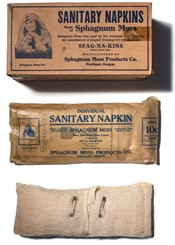
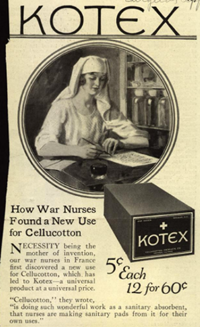
Left: Sfag-Na-Kins sanitary napkins[7]. Right: An advert for Kotex sanitary napkins[8].
The first menstrual cup: Leona Chalmers
In 1937, actress and singer Leona Chalmers patented the first modern menstrual cup. The cup was made from vulcanised rubber and was one of the most comfortable and discrete menstrual solutions to date[9]. Unfortunately, due to the negative mindset surrounding menstruation at the time, the cups did not take off commercially as they were seen as unclean because of their reusable nature. Also, it was still considered taboo at the time to use menstrual products that were inserted into the vagina.
Several years later in 1950, Leona filed a patent application for an updated design for the cup, which included air vents to aid in removing the cup and a stem that allowed users to attach string to it to aid in easier removal, both of which are still used in menstrual cup design today. She sold the patent to Robert Oreck, and he started the company Tasette, with Leona acting as a consultant and face of the brand. Due to rubber shortages from WWII, the company eventually closed in 1960[10].
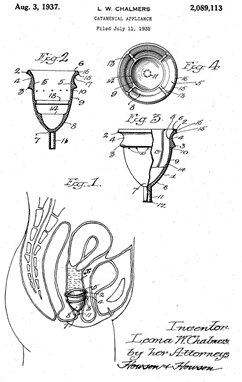
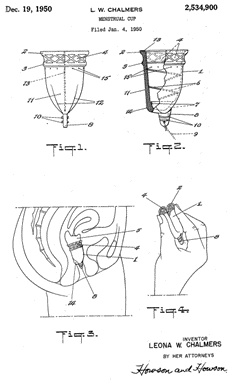
Left: Leona’s 1937 patent[11]. Right: Leona’s 1950 patent[12].
Adjustable sanitary belt: Mary Beatrice Kenner
In 1956, the inventor Mary Beatrice Kenner (known as Beatrice) was granted a patent for “a device for supporting catamenial pads or sanitary napkins on the body of the wearer”. This was a reusable device that wrapped around the waist of the user and had two straps hanging from the belt that attach to either end of a sanitary pad, holding it in place[13]. In 1959, Beatrice was granted another patent for a reusable sanitary belt including “a pocket of waterproof material” to hold the sanitary napkin using an adhesive and to prevent any leakages onto the user’s clothes[14]. Beatrice was contacted by a large menstrual product brand, Sonn-Nap-Pack, who wished to market her product, but when they found out she was black, they quickly withdrew their interest. Over the following years she was turned down by many other pharmaceutical companies due to racial prejudice, and eventually her patent expired, leading the larger companies to be free to make and sell her devices[15]. Whilst her name is relatively unknown, Mary Beatrice Kenner is the reason why most menstrual pads today have an adhesive underside.
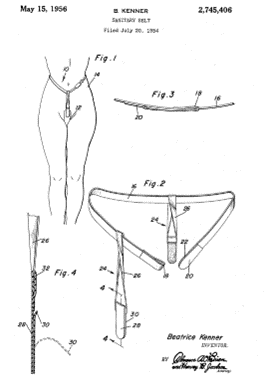
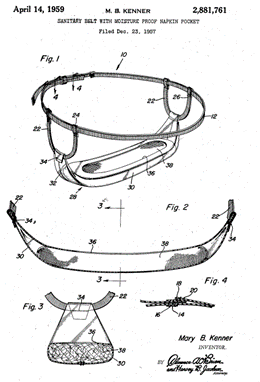
Left: Beatrice’s 1956 patent[16]. Right: Beatrice’s 1959 patent[17].
Medical grade silicon: Su Hardy (MoonCup)
Although latex rubber menstrual cups, such as the Keeper, already existed on the market in the late nineties and early noughties, some women were having allergic reactions to the latex. Su Hardy saw this happening and started researching new hypoallergenic alternatives, and came across medical grade silicone, a relatively new material to exist at the time. The MoonCup was launched in 2002 and became the world’s first medical grade silicon menstrual cup[18]. Nowadays, most of the bestselling menstrual cups are made from medical grade silicon.
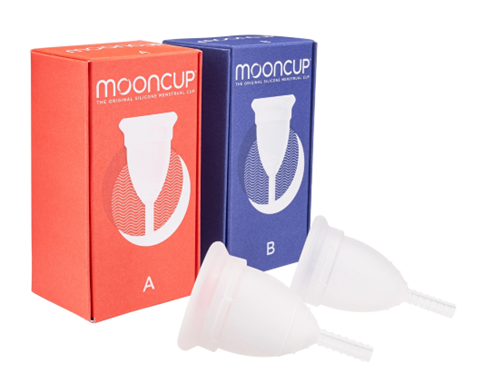
The two sizes of MoonCup available today[19].
Reusable absorbent underwear: Kristy Chong (ModiBodi)
ModiBodi is one of the leading reusable sanitary and incontinence apparel companies. Their founder Kristy Chong came up with the idea for ModiBodi while experience light incontinence during marathon training. She realised that the only solutions available were disposable hygiene products that were uncomfortable, and bad for the environment. Kristy decided to create a new solution and launched a small range of leak-proof underwear[20]. Since then the company has expanded and now provides a whole range of sustainable, reusable, absorbent apparel, including period underwear, incontinence underwear, nursing tops and reusable nappies. The apparel is made from bamboo viscose, merino wool, organic cotton and recycled nylon, and is designed to completely replace disposable absorbent solutions to be better for both the planet and the wearer’s body.
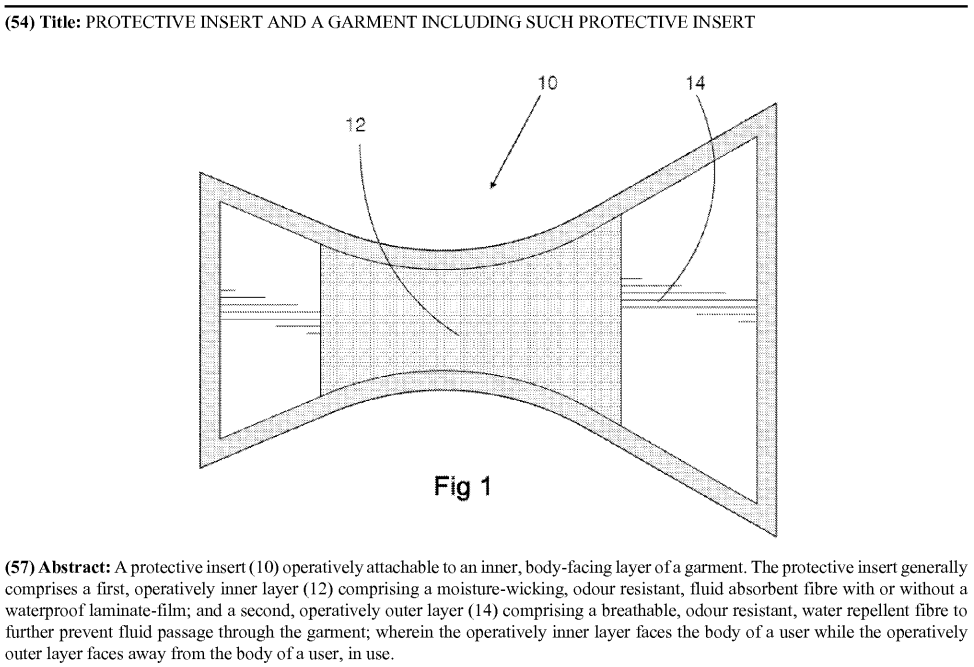
Kristy’s patent application for reusable absorbent insert and garments[21].
Go with the flow
The increase in the number of sustainable and accessible menstrual products on the market today is promising, but there are more areas of menstrual care that can still be addressed. For example, menstrual pain is the foremost cause of repeated school and work absences amongst people who menstruate[22], and yet painkillers and a hot water bottle are still the most recommended solutions[23].
However, new solutions to menstrual pain relief are starting to be explored. Sprxng is a female founded start-up out of Yale that is developing a reusable menstrual disc that incorporates therapeutic technology to provide menstrual pain relief. The pain management technology works by utilising the negative pressure created by the disc when a bulb is compressed at the base of the stem[24]. Daye is another female-founded start-up that has developed the world’s first CBD tampon, another menstrual product that is again aimed at providing menstrual pain relief, this time by using localised CBD oils to reduce menstrual pain[25].
It will be exciting to see what female-led and female-focussed innovation is developed in the next few years, including in the menstrual care sector, that will make female healthcare more accessible and more widely understood.
For advice or any questions related to your UK and European patent or design rights, please contact Charlotte Penney or your usual Kilburn & Strode patent advisor.